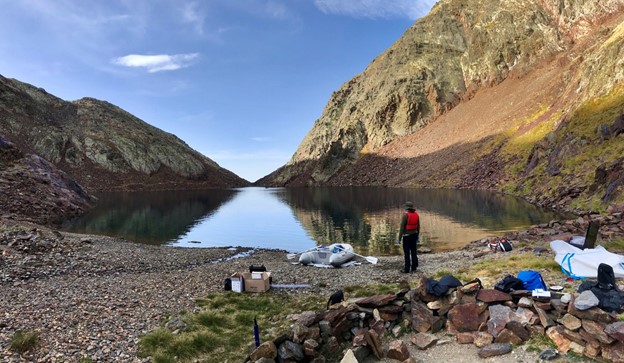Expedition begins to chart the invisible biodiversity of Pyrenean lakes
The Pyrenees region is experiencing a warming rate higher than the global average, making it a critical observatory for the impacts of climate change. Researchers from Spain, Andorra and France have begun efforts to chart the biodiversity of microorganisms living under the surface of 300 different lakes across the Pyrenees. The initiative will shed light on how invisible communities maintain the health of these unique and fragile ecosystems, helping the region prepare and adapt for the long-term impacts of climate change.
The Pyrenees are a very vulnerable region due to rising temperatures. They are experiencing a warming above the global average and this accelerates the melting of seasonal and permanent snow.
The Pyrenees region is unique because of its geography, climate and biodiversity. It is also highly vulnerable to rising temperatures. Like other mountainous areas around the world, the Pyrenees are experiencing warming at a rate higher than the global average. As temperatures rise, snow and ice melt increases, exposing darker land and water surfaces which absorb more solar radiation, leading to local feedback loops of further warming and more melting. Pyrenean lakes are particularly sensitive to these environmental changes because they receive a significant portion of their water from melting snow and glaciers, which are fast disappearing in the region. The lakes are crucial natural reservoirs which store and gradually release water for downstream ecosystems, agriculture, and human consumption.

“CREAF has been studying high mountain lakes for years and we have already mapped hundreds of lakes in the Pyrenees. For this reason, in the project, we will provide this experience and criteria to choose the 300 lakes, organize the outings and provide information on where to take the sample, what is the geology of the basin, the size of the lake, altitude, pH or biodiversity of microorganisms, among others”.
MARISOL FELIP, researcher at the University of Barcelona, associated with CREAF and member of the project team.
Also participating from CREAF are Jordi Catalan, Maria Mayol y Arnald Marcer.
What do microorganisms tell us about climate change?
A vast, invisible community of microorganisms which live under the surface of these lakes support many plant and animal species across the region. The tiny creatures are adapted to extreme cold and high UV exposure. They break down organic matter and make resources available for entire food webs. They also remove pollutants and keep the water safe to drink for downstream sources.
“Microorganisms are the most abundant and widespread forms of life on Earth, encompassing unparalleled diversity. Despite their crucial role, many microscopic life forms remain unknown, and aquatic ecosystems in remote high-altitude lakes have been particularly understudied. We want to describe this invisible world with new DNA technologies to understand how relatively fast environmental changes affect microbial communities on a global level. Our data will support a scientific framework for future conservation efforts and policy decisions," explains Hannah Benisty, researcher at the Centre for Genomic Regulation (CRG).
Dr. Benisty is the coordinator of PyriSentinel, a new three-year EU-funded project coordinated by the Centre for Genomic Regulation (CRG) in Barcelona which will address this knowledge gap. The coalition of researchers, which also includes experts from the Ecological and Forestry Applications Research Centre (CREAF), Andorra Recerca + Innovació (ARI) and the Centre National de la Recherche Scientifique (SETE-CNRS), will create a ‘family photo album’ of the invisible world of Pyrenean lakes. The project formally began today at a kick-off meeting in Ordino, Andorra.
The researchers will enlist the help of different national park authorities and citizen volunteers to help with their efforts. Together, the groups will travel to and collect water samples from more than 300 different remote Pyrenean lakes this summer, including hard-to-reach destinations at high altitudes. Priority will be given to lakes with long-term data records, as well as UNESCO world heritage sites like the Madriu-Perafita-Claror valley.
DNA sequencing
Scientists will use innovative portable devices that can sequence DNA gathered from samples both in the lab and directly in the field. The data will be made available on publicly-available data repositories as it’s gathered. The project organisers will also develop a training program for local and regional actors in the community, such as national park administrators, to enable them using the tools to monitor the microorganism diversity in the long-term.

“In this cross-border collaboration, ARI and the CRG synergistically work together to biomonitor and preserve the shared heritage of the Pyrenean biosphere. The innovative approach, combining genetic tools for bio-indicator identification, underscores the need for robust monitoring and protection in this rapidly changing region. The joint endeavour exemplifies the power of scientific cooperation in safeguarding our aquatic ecosystems,” explains Vanesa Arroyo, Manager of Andorra Research&Innovation.
PyriSentinel is funded through a 1.6 million euro grant from POCTEFA 2021-2027, an initiative by the European Regional Development Funds allocated by the European Union with the aim of strengthening sustainable development between the Pyrenees region across Spain, Andorra and France.






